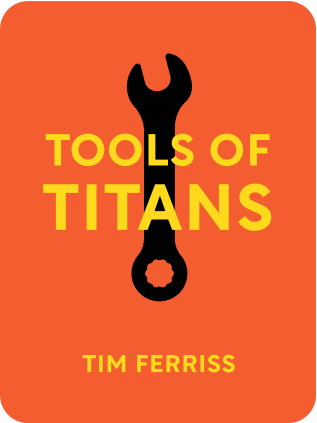

This article is an excerpt from the Shortform book guide to "Tools of Titans" by Timothy Ferriss. Shortform has the world's best summaries and analyses of books you should be reading.
Like this article? Sign up for a free trial here .
What does it really take to become successful? What are some of the most common traits that all successful people share?
If you really want to bring success into your life, you should act accordingly and that means working both hard and smart. Most people aren’t cut out for that kind of dedication which is why most people aren’t successful. The good news is that you can cultivate these qualities through practice and dedication.
Here are three traits that successful people have in common.
Are You Cut Out for Success?
In his book Tools of Titans, entrepreneur and lifestyle guru Tim Ferriss shares the habits and traits of 101 successful people, including tech investors, entrepreneurs, athletes, and entertainers. These are the principles that successful people use to achieve audacious goals, improve themselves, and be happier. The premise: if you can apply their lessons, you can be more effective.
Here are three traits of successful people that are worth the effort.
1) Action-Oriented
Are you obsessed with learning new tactics, but have a problem following through? Realize that success doesn’t come from knowledge, it comes from action.
This especially applies when reading nonfiction material like this book summary. Don’t just absorb the platitudes—think hard about what actionables you want to apply to your life.
Here are quotes and stories around taking action:
- Author Derek Sivers: “If [more] information was the answer, then we’d all be billionaires with perfect abs.”
- Author and speaker Tony Robbins: An infographic doesn’t make you a master. What matters isn’t what you know—it’s what you do, consistently.
- Artist Chuck Close: Don’t feel you need to have that perfect idea before you start doing. Most likely you’re just holding yourself back. Only amateurs rely on inspiration—experts just get to work. While working, you’ll find new opportunities that wouldn’t be obvious if you just sat there thinking.
- Youtuber Casey Neistat: You can never count on being the most capable, most talented, most attractive person. But you can always compete by working hard.
- Entrepreneur and investor Naval Ravikant: Free information is everywhere on the Internet. What’s scarce is the desire to learn it.
- Filmmaker Rob Rodriguez: While in college, Rob started a comic strip. He’d try to get ideas by staring at the wall, but then found he was much more successful when he just started drawing and improving on it. If you wait for inspiration to hit, you’ll never act.
- Comedian and actor BJ Novak (The Office): Commit to future actions when you’re in a high energy state, so you can’t back out. He suggests first-time comics book their first week of shows well in advance, so they can’t back out after a bad performance.
Everyone starts somewhere. If you need a dose of courage, look at the earliest blogs of Tim Ferriss or Ramit Sethi, the earliest podcasts of the Joe Rogan show, or watch the pilot of hit TV shows. The titans you see today started out no better than their rough drafts, and you don’t have to do any better than that to get started.
Defeating Procrastination
Have a problem with procrastination? It might be caused by anxiety about the task. To combat this, Tim Ferriss forces himself to write down 3-5 things that are making him the most anxious. Then he asks himself,
- If this were the only thing I accomplished today, would I be satisfied with my day?
- Will doing this make all the other to-dos unimportant or easier to do later?
If so, he blocks out 2 to 3 hours to focus on one of them.
(Shortform note: For more on the idea that what is often most important is what scares you the most, read our summary of Eat That Frog.)
Focus on the Process, Not the Goal
When you set ambitious goals for yourself, it’s frustrating to put in time but not make visible progress. Then it’s easy to lose motivation and stop doing the work. To get through rough patches, you need to simply do the work.
If you commit to a long-term goal, then only one decision needs to be made and adhered to—put in the work. This is easier than having to make lots of little decisions on what to do each day, which can be fatiguing and cause you to go astray.
US gymnastics coach Christopher Sommer: “Show up, do the work, and go home.”
2) Focused on Incremental Improvement
Want to lose 50 pounds, or meditate for half an hour daily, or read a book a week forever? These are big goals—maybe too big. If you chew off too much at the start, you might falter and feel self-defeated.
Instead, try just one small action. No one ever has too little time or energy for one tiny action. Having one successful small action builds momentum to adopting your habit.
- WordPress founder Matt Mullenweg: to get in shape, he committed himself to one push-up before bed.
- Former Google employee and author of Search Inside Yourself, Meng Tan suggests taking just one mindful breath a day.
- Music producer Rick Rubin: Artists who struggle to produce should just write a single word. Could they summon the energy to write just one word?
(Shortform note: The point of this tactic is that if you visualize a giant goal, the barrier to action is very high. If you falter, you’ll be disappointed with yourself, setting off a vicious cycle and cutting off your progress. Instead, distill your behavior change into the tiniest possible unit. Commit to doing just that one little thing. You’ll find it’s not as bad as you thought. For more on this idea, read our summary of Atomic Habits.)
3) Daily Routines
Several titans discussed their daily practices at the beginning and end of each day.
Morning Routines
Getting the start of your day right prepares you for success the rest of the day.
Tony Robbins changes his body physiology to prime himself into the right mental state. He starts with a cold-water plunge, then follows with rapid breathing exercises or a short walk. He then ends with a meditation on what he’s grateful for and what his goals for the day are.
Tim Ferriss has 5 morning rituals:
- Make your bed.
- Getting the day ready with a small task encourages you to do another. And no matter how bad your day goes, you can make your bed. This gives you some feeling of control. (Shortform note: Read an expansion of this idea in our summary of the book Make Your Bed.)
- Meditate.
- Do 5 to 10 reps of a physical exercise, like pushups or squats.
- Make titanium tea, a combination of:
- Pu-erh aged black tea
- Dragon well green tea
- Turmeric and ginger shavings
- 1-2 tablespoons coconut oil
- Write in his 5-minute journal
- Answer the below questions with 3 answers each
- I am grateful for…
- What would make today great?
- Daily affirmations. I am…
In her book The Artist’s Way, writer Julia Cameron notes that journaling daily acts like “spiritual windshield wipers”—once you get your confusing thoughts on paper, you can see the world through clearer eyes.
LinkedIn founder Reid Hoffman finds the morning is when his mind is the freshest, and he spends 60 minutes working on the problem he set for himself the day before.
Navy SEAL and author Jocko Willink wakes up by 4:45 AM. While he was a warfighter, he felt this gave him a psychological advantage over his enemy—while his enemy was still sleeping, Jocko would be readying himself for their encounter.
End of Day Routines
Thomas Edison said, “Never go to sleep without a request to your subconscious.” Accordingly, Reid Hoffman gives his mind an overnight task, like a product design conundrum or a business strategy problem. He lets his subconscious mind get to work.
Like his start-of-day journal, Tim Ferriss has an end-of-day journal, where he answers two questions:
- What are 3 amazing things that happened today?
- How could I have made today better?
End the work day with high-quality work—don’t develop a bad habit of producing poor work at the end of the day. Ernest Hemingway ended his writing sessions mid-flow and mid-sentence so he could start with momentum the next day.

———End of Preview———
Like what you just read? Read the rest of the world's best book summary and analysis of Timothy Ferriss's "Tools of Titans" at Shortform .
Here's what you'll find in our full Tools of Titans summary :
- The habits and beliefs of 101 people at the top of their game
- Tim Ferriss' list of 17 questions you should ask yourself to challenge your thinking
- How emulating the habits of successful people you look up to can make you successful as well






